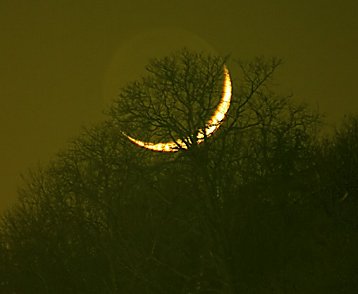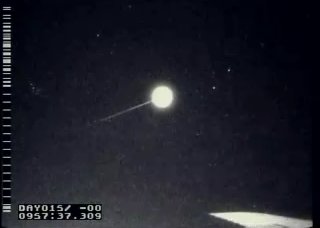 Would you like a call when SuitSat orbits over your home town? Sign up for SpaceWeather PHONE.
Would you like a call when SuitSat orbits over your home town? Sign up for SpaceWeather PHONE.
ASTRONOMY CLUBS: Do you publish an astronomy club newsletter? Or would you like to? If the answer is "yes," you can receive free articles about current events in astronomy written by Dr. Tony Phillips. Sample: Snowstorm on Pluto. Contact Nancy Leon of JPL's Space Place for details.
THE DA VINCI GLOW: Tonight, when the sun is setting, step outside and look west. You can see a display of light and shadow that puzzled skywatchers for thousands of years--until Leonardo Da Vinci figured it out. It's the Da Vinci Glow, also known as Earthshine:

The crescent moon photographed on Jan. 31st by Denis Joye near Paris, France.
Cradled in the arms of tonight's crescent moon is a glowing image of the full moon. Da Vinci's explanation: The glow comes from Earth. Sunlight reflected from our own planet lights up the lunar night, allowing us to see the full moon, faintly, two weeks before the moon is actually full. A crescent moon with Earthshine is one of the prettiest sights in the heavens--don't miss it!
MUST-SEE VIDEO: On Jan. 15th when the Stardust capsule ripped through Earth's atmosphere en route to a parachute landing in Utah, no one had a better view than scientists onboard NASA's DC-8 Airborne Laboratory, and they recorded a spectacular video. Click on the image to see it:

Stardust Reentry Video (6 MB)
Credit: Mike Taylor, Utah State University
The glowing head of this man-made meteor reached temperatures exceeding 4000 degrees F. Inside the capsule, delicate samples of dust collected from distant Comet Wild 2 were safe, protected from blistering heat by the capsule's external heat shield. The cargo is now being studied by scientists at the Johnson Space Center who believe it may reveal secrets of comets and the origin of the solar system.
BONUS: In addition to the man-made meteor, there are two natural meteors in the Stardust video. Can you find them? Hint: one is near the 4-second mark; the other near 59-seconds.

